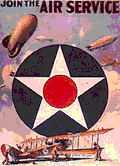 Contents:
Contents:
Author:
Lutz Pietschker
Version: 2001
Games | Home Page | Links | What's New
Please note that with the exception of the counters the graphics shown here are not original graphics from the game. Some graphics are courtesy of Mike Iavarone's Trenches on the Web WWI website.
 A misty morning, thank God. This is the second week of April, 1917, and you have just received orders to provide photo reconnaissance of a rail yard your HQ is planning to disrupt. Taking photos will not be easy in the murk, but at least your men should have a reasonable chance to escape "Archie" and the German fighters on the way in and out. The task will fall to "A" Flight who should be back any moment now from the dawn patrol- yes, here they come. One, two, three- all of them are there. This is, in fact, the first good news you have had for some time now. After the losses of the last ten days resources are stretched pretty thin, the last reserve planes being used and no hope for pilot replacements for some days to come.
A misty morning, thank God. This is the second week of April, 1917, and you have just received orders to provide photo reconnaissance of a rail yard your HQ is planning to disrupt. Taking photos will not be easy in the murk, but at least your men should have a reasonable chance to escape "Archie" and the German fighters on the way in and out. The task will fall to "A" Flight who should be back any moment now from the dawn patrol- yes, here they come. One, two, three- all of them are there. This is, in fact, the first good news you have had for some time now. After the losses of the last ten days resources are stretched pretty thin, the last reserve planes being used and no hope for pilot replacements for some days to come.
Anyway, no use to ponder, you can't refuse any missions without putting a big black mark against your name, and then the support you provide is desperately needed, isn't it? So off they go, the lumbering F.K.8 two-seater, accompanied by three fighters for protection. You just hope young Collis-Johns makes it. They are shot down so easily on their first sorties!
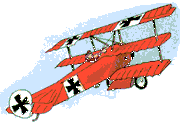 Well, it does not take long and bad luck catches up as the engine of McNair's Sopwith begins to cough and splutter. No use to go on, flight leader 'Tiny' Street signals the pilot to straggle back to the next emergency airfield. If he makes it at least plane and pilot will be back in service next day.
Well, it does not take long and bad luck catches up as the engine of McNair's Sopwith begins to cough and splutter. No use to go on, flight leader 'Tiny' Street signals the pilot to straggle back to the next emergency airfield. If he makes it at least plane and pilot will be back in service next day.
But you begin to smell danger. The mist gets thinner, just as you approach the trench line, and your worst fears come true: You see the bright red airplanes of Jasta 11 head towards you. Von Richthofen himself! Cunning devils, they must have anticipated your mission. Seconds later seven planes swirl around in a dogfight, but of course the slow 2-seater does not stand a chance. Even as one Jasta plane breaks off, trailing smoke from a lucky hit of the observer's MG, the "Red Baron" fires a long burst into the F.K.8 and you see the pilot must be hit. The plane begins to spiral down, levels out, and begins a wobbly but frighteningly fast descent. There goes the plane that carries the camera- your mission is over before it really began.
Go back to the top
Other reviews: see the Web Grognard's site
Other titles by Lambourne Games: Sports replay games (for a complete list see the Sports Game Shop)
Here are a couple of Internet links on WW I aviation:
Go back to the top
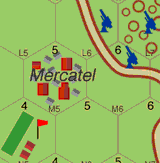 Game Concepts
Game Concepts
The player is in the position of the commanders of one or more flights of No. 23 Squadron, Royal Flying Corps, and manages the assignment of planes and pilots to the daily missions as well as actually flying the missions. Possible missions include photo reconnaissance, artillery spotting, patrols, trench-strafing and balloon bursting. You have available a pool of planes and pilots for each of the 3 flights of the squadron; you may play one, two or all three flights during the campaign but each flight is managed independently from the others so if you take more than one you play, in effect, two or three parallel games. The German fighters and anti-aircraft artillery are handled by the game system.
A complete campaign has 21 days (April 1st to 21st, 1917), and each flight may be requested to fly 2 to 5 missions per day. You assign planes and personnel to the missions as you see fit. Some missions have minimum demands you must meet, e.g. photographic reconnaissance requires at least one two-seater in the mission. Pilots must fly one mission per day but may not fly more than two (plus special tasks). The planes' properties are summarized in an initiative table on the aircraft card; the only other properties are the number of seats and guns, ceiling altitude and maximum Air Flying Time (AFT).
Pilots are rated for flying and firing skills and for bravery. Also, the number of missions flown and the number of kills is given. The ratings are subject to changes, depending on mission success and individual performance.
Each morning the required missions are rolled for; an additional dawn patrol must be flown every third day. Brave pilots may also be sent on an optional evening "twilight patrol" for a nightcap, a great way to earn a medal- often posthumously, alas. Weather is rolled for, and a forecast is given that may or may not be correct (remember, it's April). Weather affects encounter probability, dogfight duration, visibility and photo quality.
Now you must study the mission requirements and decide upon a preliminary assignment of forces. For each mission a mission log sheet is filled out prior to take-off. Turning down a mission request incurs a hefty deduction from the victory point account, but at times you may be forced to do so.
Flying a mission is done on the geographical overview map as long as no enemy planes are encountered. For each one-hex-move of the flight you roll for a weather change. You then move and/or climb or dive, deducting AFT used; a plane that is out of fuel will have to do a forced landing. Then you check for anti-aircraft-artillery ("Archie") or machine gun fire and resolve the effects. At last, you roll for an encounter or an engine failure. The encounter probability is derived from the encounter number of the hex and modified by weather conditions and possible "Archie" activity, and behind the German lines encounters become quite probable on a sunny day. If there are neither German planes nor mechanical trouble you may move to the next hex.
"Archie" is resolved in a simple, random and "graphical" way: You place your planes on a 6 by 6 grid as you please and then roll the dice a few times. Each die roll "hits" one grid square, and if you happen to have a plane there, well, that is bad luck indeed. After all shots have been taken you end up with an overhead view of your planes in "formation", with puffs of flak bursts between them. Surely a table could give equivalent results, but what are statistics against being able to seethe danger!
For an encounter, the number and type of enemy aircraft is checked and their altitude rolled for. German pilot skills are noted on the aircraft counters. The all-important initiative value is a function of the difference in altitude, type of plane, pilot skill and a roll of dice. The planes attack in order of initiative, and the initiative difference transforms into a more or less dangerous attack. Hit results are resolved immediately, and only disabling results are covered, there is not whittling away of hit points. A hit is either critical or not recorded at all.
For your own planes you have to keep track of ammunition. Weapon jams are possible for both sides. The dogfight system is abstract insofar as you do not actually fly manoeuvres like turning and looping, all this is factored into the initiative tables. Planes with the same initiative value are paired off into "personal duels" that tend to be rather deadly.
The exact dogfight duration depends on the weather and some dice rolls, 4-8 rounds are common, and each round costs additional AFT. After that you pick up what is left, record victory points for downed Huns, deduct points for your own losses and move the squad to the next hex. Planes falling out of formation ("stragglers" and "lame ducks") are put aside, their fate is decided after mission completion.
A mission completes once all your planes are back on ground level, one way or other, and as pilots use to say, "it was a good landing if you walked away from the plane on your own feet". Some missions just are a trip to the trench and back, but most of them are a bit more involved. For photo missions, for example, you may decide to spend additional turns over the target to increase your chance to get maximum victory points for a good shot (especially when visibility is bad). Of course, you risk to fall victim to flak or German fighters each turn, and sometimes you will not make it back to the base but have to land on advance landing fields for lack of fuel. The latter is no disaster but may cost some victory points, and your planes and pilots will only be back next day.
Go back to the top
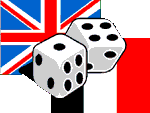 As with many other solitaire games, the first thing will you do is to assemble the maps, tables and other components around you and begin to read. There is short introduction to the historical background and a detailed introduction to the game itself. Since the rule book is organized in the sequence of play you may start with page 1 and work your way through the rules as they are needed.
As with many other solitaire games, the first thing will you do is to assemble the maps, tables and other components around you and begin to read. There is short introduction to the historical background and a detailed introduction to the game itself. Since the rule book is organized in the sequence of play you may start with page 1 and work your way through the rules as they are needed.
You will have to start the game with book-keeping, mainly entering those curious British pilot names into the squadron report sheet with their skill factors. This done, game play begins with the first mission for day 1 (April 1st). You write a mission log for each mission, stating the objective, planes and pilots employed, and keeping track of encounters, flying time and ammunition. Obviously, you will plan a mission route that keeps you over friendly territory, away from "Archie" and at low encounter probabilities as long as possible. Also, you often want to fly rather high than low. All of these pleasures are often denied by the limited air flying time at your disposal, which may force you to take a rather blunt in-and-out approach.
After planning the route you just move and pray- don't roll low (encounters!), and don't roll boxcars (mechanical failure!). Once the Hun appears you will be limited to reaction in dogfight mode unless you have the upper hand in initiative. You are free to decide which enemy plane to take on, but then it could be best to evade and run for it. As simple as some decisions seem to be, the need and greed for victory points is always there. Similarly, once over the target you may want to make sure the dangerous trip was not wasted, so you circle while waiting for the clouds to part and hope von Richthofen does not find you and that you do not run dry on the way out. Believe me, you will feel a surge of relief once you got French soil below you again.
The core of the game is an intricate system of chances and probabilities, and there are some factors that are not under your control, just like in real life. Nevertheless you have far more control and excitement than, for example, in Avalon Hill's "B-17". In best solitaire game tradition there is a lot of rolling the dice and looking up tables, but not so many that they distract from the real task at hand. Also, since usually many relevant factors are summed up into just one property value, the game plays reasonably fast by concentrating on the essentials and leaving some of the details to your imagination. And this is the one thing I want to say before I make a few remarks about the game material: It is not very often that you get such a lot of atmosphere, and feeling to be "in the midst of action", out of a few sheets of cardboard and a simple map. You may have guessed by now that I like the game a lot!
Go back to the top
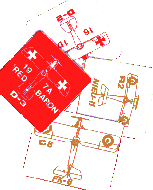
If you know Lambourne Games you will more or less know what to expect. While Terry Goodchild is not easily satisfied with the conceptual design of a game, he keeps the production "chrome" at a very basic level indeed. Rare for a Lambourne game, this one in fact comes in a large (if somewhat wobbly) box and has a folding mounted board for dogfight resolution. The other components are closer to the usual style, i.e. black-and-white print on white or coloured cardboard, with very few graphics and typewritten text. Functional, you might say. The counters are a bit of a surprise as they are printed on 1 mm plastic sheets. You must cut them out yourself, but they are almost indestructible and are a nice change from those fluffy counters, badly die-cut from cheap cardboard, that are so common in other wargames.
As in most Lambourne games the rules are written very clearly, no questions go unanswered. What's more, they are a pleasure to read. The author obviously not only knows what he is writing about, but he also had fun doing it. Small wonder- the game is the offspring of a book Terry Goodchild wrote about that same topic. Unfortunately, it was never published.
The rule booklet has an index on the back cover. Parts of the rules have been "outsourced" to the table sheets, and this took me some time to get used to. Though they usually are where they belong, on your first few sessions you may go windmilling about the living room table a bit to find the procedure you are looking for.
So if you do not get a game that is visually enticing at first sight you get good value nevertheless, and I prefer a solid system to flashy graphics any time. Also, there are sound reasons for the low-profile production: Lambourne's are very small publishers indeed- just Terry and his wife June, and they do not expect sales in excess of a few hundred copies per year of any of their 30 or so in-print titles. This obviously limits the expense they can afford, so neither a professional graphics designer nor colour printing were deemed practical. It is a pity indeed- what a game this could have been if a larger company had licensed the design and produced it to the standards that are possible with a print run of some thousand units and a good distribution system!
The game currently has all but sold out, and perhaps current desktop publishing tools and a little help from his friends will encourage Terry Goodchild to do a 2nd edition. It probably depends on whether or not he sees ongoing interest in the game.
Note (2007-10-23): There are reports that the game components sold now are even flimsier than I described them in 1998 (or so) and are of unsatisfying quality. Please note that I am not involved in the production of the game; please contact Lambourne Games before you buy if you want to be sure what you get.
Go back to the top
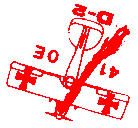
Go back to the top
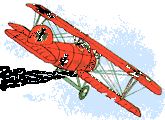 Happily, the rest of your reconnaissance flight has managed to break away from von Richthofen's Jagdstaffel. Now that the mission is busted, all that remains to do is to get home without any more losses. You have no idea how to keep enough men and planes flying for another week to fulfil all the tasks you will be assigned; you just have to hope that the laws of averages may bring good luck to compensate for the past disasters. "Bloody April" indeed.
Happily, the rest of your reconnaissance flight has managed to break away from von Richthofen's Jagdstaffel. Now that the mission is busted, all that remains to do is to get home without any more losses. You have no idea how to keep enough men and planes flying for another week to fulfil all the tasks you will be assigned; you just have to hope that the laws of averages may bring good luck to compensate for the past disasters. "Bloody April" indeed.
Your remaining fighters manage to land undamaged. There is news about McNair already, he is safe, with only minor damage to his fighter, and he will be back tomorrow. And then Lady Luck smiles really brightly on you: A call from the town of Mercatel informs you that Billy Koda managed to get his F.K.8 down in one piece on a dirt road, after all, and that his injuries are not as severe as you thought. His observer even took a picture of the scene with the reconnaissance camera.
Hang on. Just 8 more days to go.

Go back to the top
As the author of this page I take no expressed or implied responsibility for the content of external links; opinions expressed on such pages are not necessarily mine. The web space provider is not responsible for the contents of this page or any linked pages.
Written and published by Lutz Pietschker. Please send comments about technical problems to the
site master.
-Made with a Mac!-
, last change 2011-03-12